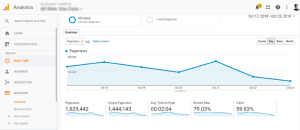Experienced agile marketing teams can improve their efficiency by setting and adjusting work in progress limits.
We recently introduced you to the Agile Marketing Navigator, a flexible framework for navigating agile marketing for marketers, by marketers in the article A new way to navigate agile marketing. The navigator has four major components: Collaborative Planning Workshop, Launch Cycle, Key Practices and Roles. Within these categories, there are several sub-pieces for implementation.
In recent articles we covered the Collaborative Planning Workshop and the Launch Cycle. Now we’re going to dive into the third of our 6 Key Practices: Work in Progress.
Marketers are overloaded
Let’s face it, marketers have a big problem — they’re overloaded with too much work. A big consequence of too much work happening at once is getting a lot of work started, but nothing really finished.
In agile marketing, a primary goal is to deliver work rapidly so we can get feedback to inform future work. However, when marketers are spinning in a sea of content creation soup or email overload, work is often getting caught up somewhere in the internal workflow and not getting delivered as quickly as it should.
Understand the team’s current work in progress
Work in Progress (WIP) limits derive from the popular workflow framework Kanban and it’s a practice that helps teams understand optimal workflow.
Let’s say that you’re a content marketing team and you’re visualizing your work in an agile tool such as Workfront or JIRA. The team notices that they could be more efficient at getting work from “in progress” to “done” and that limiting how much work is in progress at any given time may help them be a better-performing team.
To get started, the team should take a few weeks to track how much work they currently have in practice each day, coming up with an average. Here’s a simple way to calculate the team’s current WIP by jotting down what’s on the team’s board:
| Day | Number of work items in Progress |
| 1 | 8 |
| 2 | 10 |
| 3 | 7 |
| 4 | 9 |
| 5 | 12 |
| 6 | 9 |
| 7 | 13 |
| 8 | 12 |
| 9 | 10 |
| 10 | 11 |
| 11 | 12 |
| 12 | 13 |
| 13 | 8 |
| 14 | 9 |
| Average WIP | 10 |
To calculate the team’s current work in progress, add up the total in column 2 and divide by 14, which gives an average of 10. This means that the team averages 10 items in progress at any one time.
Experiment with WIP Limits
Now that the team understands their starting place, they can experiment by setting different WIP limits. Since they know that with 10 work items in progress at any given time they are not at optimal efficiency, they should agree to set a lower limit, such as eight, and experiment over the next few weeks by not allowing more than eight pieces of content to be in progress at once.
After that two-week period, the team should discuss how it went. Did they see any improvements in how much work got done? If yes, they may have found an optimal number. If they believe it is still too high, they can try another cycle with a lower number.
It may take several experiments to understand the team’s WIP limit, and that number may change over time. The main point is that the team is empowered to set this themselves and to work together to improve their efficiency.
This isn’t a beginner’s practice, so I recommend only trying this with teams that have been working in agile marketing together for six months or longer and have mastered the basics. This practice is more about refining and optimizing a relatively experienced agile marketing team to improve efficiency.
The post Work in Progress Limits: Getting started with the Agile Marketing Navigator appeared first on MarTech.
MarTech(34)
Report Post





